Preface: Renewed military confrontations[1] between Syrian armed opposition factions in Eastern Ghouta added burden on civilians who have been besieged for several years by Syrian government forces in all Eastern Ghouta cities and towns. Although Army of Islam[2] and Failaq al-Rahman[3] in May 2017 reached an agreement to end the military confrontations that erupted between them on April 28, 2017. However, those confrontations returned to the front again after last confrontations claimed lives of dozens of soldiers and number of civilians.
On September 17, 2017, military confrontations renewed between Failaq al-Rahman from one side, and Hayat Tahrir al-Sham /HTS[4]/ and Rabetet Al-Marj Brigade[5], on the other hand, because Rabetet Al-Marj seized houses inhabited by displaced in the town of Kafr Batna. According to a Syrians for Truth and Justice/STJ/ reporter, these clashes resulted in killing a civilian and several casualties as well.
Against the background of the above-mentioned military confrontations, several residents of Hamoryah town demonstrated on September 28, 2017 to demand a cessation of hostilities and removal of faction’s checkpoints scattered all over Eastern Ghouta. However, this demonstration headed from Hamoryah towards Beit Sawa[6], it was met by shooting live bullets by Army of Islam, which caused two wounded among demonstrators.
On August 6, 2017, violent military confrontations erupted between all armed opposition factions in Eastern Ghouta, Failaq al-Rahman, Ahrar al-Sham al-Islamiyya[7], Hayat Tahrir al-Sham /HTS/, and Army of Islam, resulted in killing a civilian, that pushed Irbin locals to demonstrate demanding to stop those confrontations, but Hayat Tahrir al-Sham /HTS/ faced them with throwing stones, resulted in several injuries among the demonstrators.
Political and Military Context:
On May 4, 2017, sponsor states of Astana talks (Russia, Turkey and Iran) signed a Memorandum of Understanding for establishment of de-escalation zones in Syria, it included Eastern Ghouta in Damascus countryside, Idlib province and some parts of northern Homs, as well as some parts of adjacent provinces (Latakia, Hama, Aleppo) and parts of southern Syria. One of the most prominent items is cessation of hostilities between conflicting parties and creation conditions for access medical aids, the last convoy entered Eastern Ghouta was on July 27, 2017, it was five trucks of the Red Crescent loaded with medical supplies materials, medicines and vaccines.
On July 22, 2017, the Army of Islam participated in signing de-Escalation zone agreement in Syria, followed by Failaq al-Rahman, on August 18, 2017, as the Russian side and Failaq al-Rahman agreed to cease fire and continue to fight al-Nusra Front as well.
Militarily, Eastern Ghouta is under control of Syrian armed opposition since late 2012, along with several factions such as Army of Islam, Failaq al-Rahman and Ahrar al-Sham al-Islamiyya Movement as well as Hayat Tahrir al-Sham (HTS) which holds some headquarters in Failaq al-Rahman control areas.
In April 2017, Army of Islam waged a campaign to uproot HTS/al-Nusra Front in Eastern Ghouta, the campaign lasted almost one month and resulted in decreasing the presence of HTS to some limited headquarters in the outskirts of Irbin town and some areas of Hazeh and parts of Al-Ash’ari farms. However, during the campaign, Failaq al-Rahman interfered to counter Army of Islam, so the military confrontations expanded, and ended with retreat of each faction into its areas of control. Consequently, Duma , Mesraba, Ottawa, Al-Nashabiyah , Shifuniyah, and some of al-Ash’ari farms became under the control of Army of Islam, whereas Irbin area became a joint control area between Ahrar al-Sham al-Islamiyya, Failaq al-Rahman and HTS/al-Nusra Front, Hazeh area became a joint control area between Failaq al-Rahman, HTS/al-Nusra Front, Hamoryah area became a full control zone of Failaq al-Rahman, Saqba area became a full control zone for Failaq al-Rahman, Kafar Batna district became a Joint control area between HTS/al-Nusra Front and Failaq al-Rahman, areas of Jisreen, Zamalka, Jobar and Ein Tarma became full control areas of Failaq al-Rahman, Madyara and Beit Sawa areas are full control of Failaq al-Rahman except for some farms controlled by Army of Islam until the date of writing this report in October 2017, and Harasta is a full control area of Ahrar al-Sham Islamiyya / Liwa Fajr al-Islam formerly.
A map illustrate areas of control by opposition factions in eastern Ghouta until the beginning of November 2017.
First: Forcibly Seizure of Displaced Houses in Kafr Batna:
On Sunday, September 17, 2017, at about 01:00, after midnight, fighters of Rabetet Al-Marj Brigade in Kafr Batna town, which is under joint control of Failaq al-Rahman and HTS, seized houses specialized for the displaced coming from the town of Ein Tarma, the displaced came because of the recent military campaign launched by the Syrian government forces on the town in mid-June June 2017. Therefore, as a result, people of the town filed a complaint to the town police station and requested the help of Failaq al-Rahman to get Rabetet Al-Marj Brigade out, this matter caused erupting clashes between Failaq al-Rahman on one hand and Rabetet Al-Marj Brigade, supported by HTS on the other, that is confirmed by Abu Ahmed, an alias for one of the residents, one of the eyewitnesses who was present at the scene, as he spoke to STJ saying:
“Clashes between the warring factions did not last for long time; they ceased but without getting families of Rabetet al-Marj brigade out, those who have been housed instead of the displaced. This pushed people of Kafr Batna to demonstrate at dawn, demanding evacuation of the houses, as oral disputes occurred between them and members of HTS who supported Rabetet Al-Marj Brigade, then evolved into throwing stones by people on HTS fighters, this sparked shooting. At once, Failaq al-Rahman fighters intervened, so clashes erupted between them and HTS and lasted several hours.”
In a cross-checked testimony, a media man, was in the area of clashes, confirmed that a group of HTS snipers got on top of buildings located on the outskirts of Kafr Batna from Hazeh side, cutting roads to Kafr Batna from the side of Hazeh, Ein Tarma and Zamalka, and also obstructing movement of civilians due to exchange gunfire that continued until the wave of clashes subsided after several hours at the same day.
According to STJ reporter, the military confrontations resulted in the death of a civilian identified as Ziad Ghoneim, as a result of gunshot in his head, as well as three soldiers died.
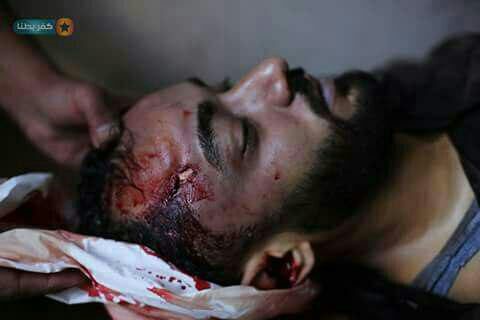
Image shows the victim Ziad Ghoneim who was killed in the clashes between Failaq al-Rahman on one side and Rabetet Al-Marj Brigade and Hayat Tahrir al-Sham on the other, on September 17, 2017.
Photo credit: a media man from Eastern Ghouta.
In turn, the local council of Kafar Batna issued a statement condemning the attack on civilians by Rabetet Al-Marj brigade, demanding the Revolutionary Command of Damascus and its countryside and Failaq al-Rahman to assume their responsibilities and get Rabetet Al-Marj Brigade and HTS out of the town.
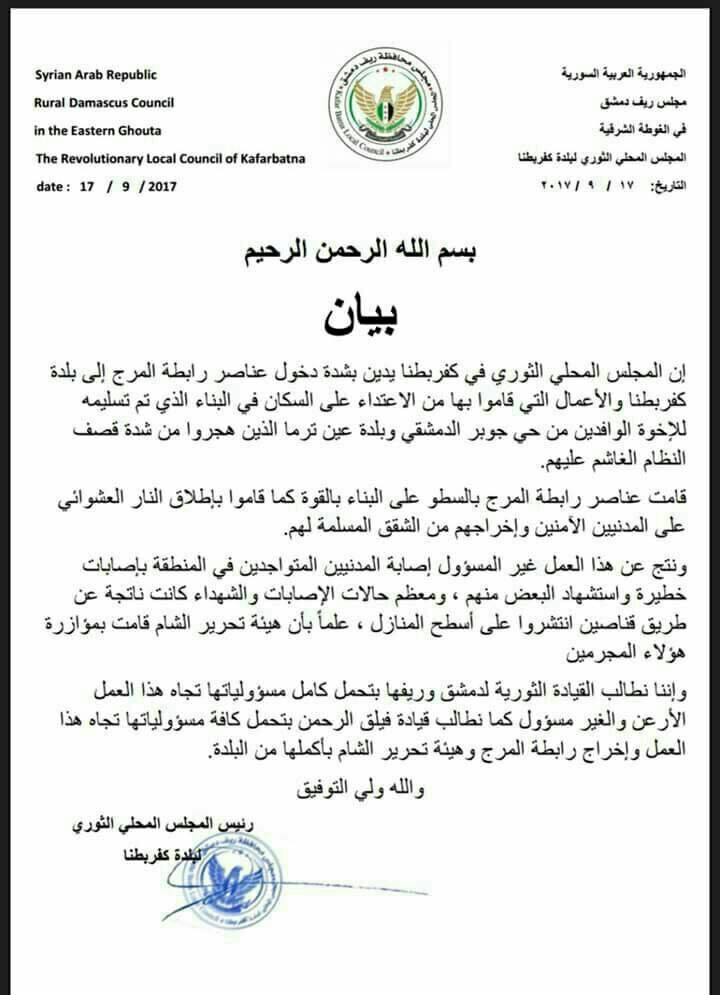
The statement published by the local council of Kafar Batna on September 17, 2017, condemning the attack on civilians by Rabetet Al-Marj brigade, demanding the Revolutionary Command of Damascus and its countryside and Failaq al-Rahman to hold their responsibilities and get Rabetet Al-Marj Brigade and HTS out of the town.
Photo credit: Facebook account of Ghouta center
Second: Assault Demonstrators by Army of Islam:
Confiscating houses of displaced civilians by Rabetet Al-Marj Brigade in Kafr Batna increased discontent among people of Eastern Ghouta whom already suffered from spreading checkpoints of opposition factions along Eastern Ghouta, as a result of military confrontations among themselves. Anyway, it was just days on that incident until it was followed by another incident in Failaq al-Rahman-held Beit Sawa town, except some farms held by Army of Islam until the date of writing of this report in October 2017, when director of the medical point identified as Ahmed al-Asfer was injured following shooting fire by Failaq al-Rahman fighters on September 27, 2017. This pushed Beit Sawa residents to demonstrate and attack Failaq al-Rahman headquarters, so they get them out of the town and removed its checkpoints.
The next day, September 28, 2017, people of Hamoryah demonstrated demanding the removal of Failaq al-Rahman checkpoints installed between Hamoryah and Beit Sawa; the demonstration continued marching until it reached the outskirts of Beit Sawa, specifically at what called Al-ahlam factory where one of Army of Islam checkpoints existed. However, as one eyewitness, who refused to disclose his name for security purposes, assured to STJ that elements of the checkpoint shot demonstrators and injured two people, one of them in his flank and the other in his hand.
According to STJ reporter, Army of Islam sent a delegation that met the demonstrators who demanded removal of checkpoints between them and their lands, the delegation offered that Army of Islam withdraw from the territories and transform Hamoryah and Beit Sawa regions into towns free of any military presence. The meeting concluded to present this solution to Failaq al-Rahman, but until the date of this report, the results of this meeting have yet come true.
A video footage published by Smart Media Agency on September 30, 2017 documented shooting of demonstrators by Army of Islam in Hamoryah town and injuring two demonstrators as a result.
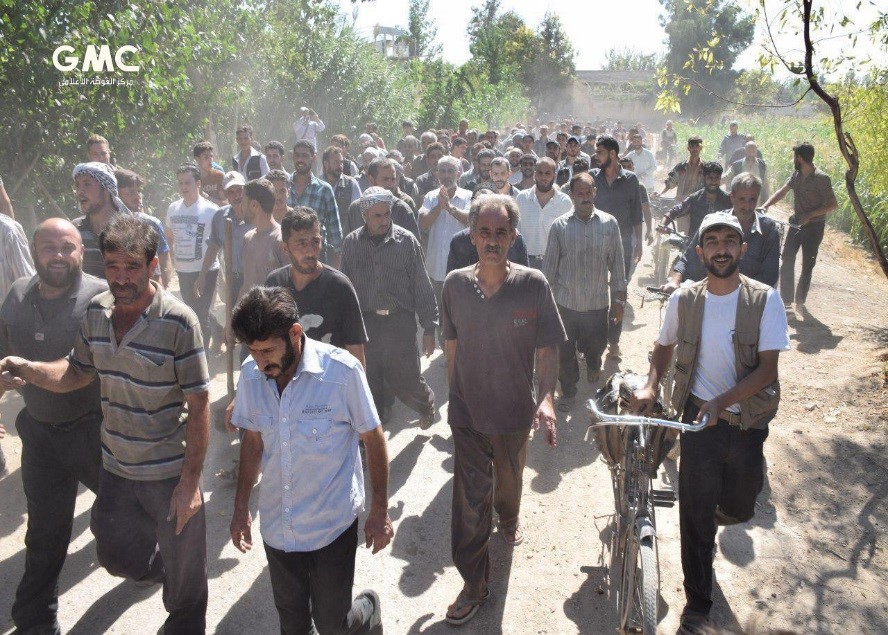
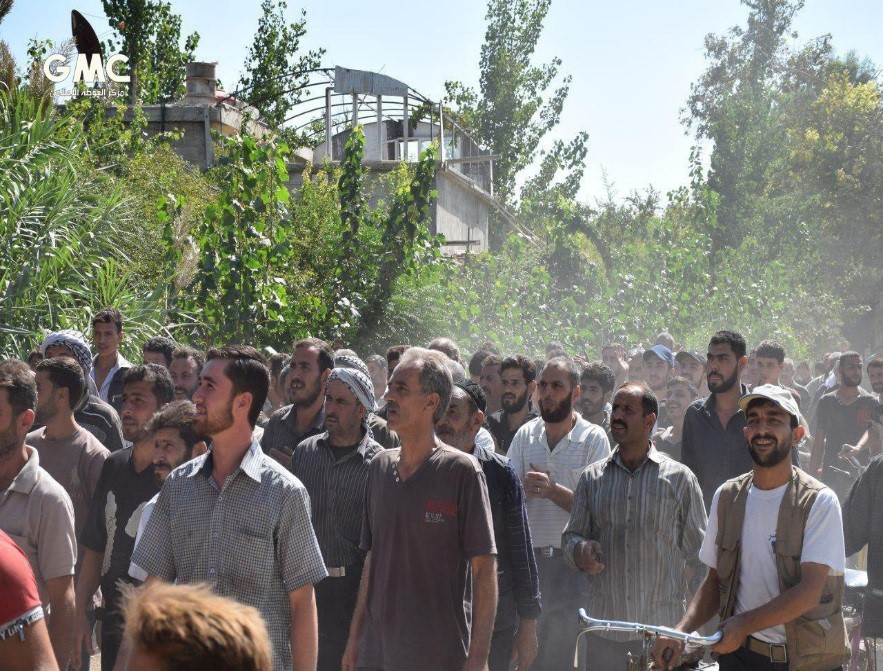
Images showing the demonstrations that took place from Hamoryah to the town of Beit Sawa on September 28, 2017, demanded removal of Failaq al-Rahman checkpoints located between Hamoryah and Beit Sawa.
Photo credit: Facebook account of Ghouta center
Third: Attack Demonstrators in Irbin by Hayat Tahrir al-Sham – HTS
On Sunday, August 6, 2017, military confrontations erupted between all armed Syrian opposition factions in Eastern Ghouta, after some elements of Ahrar al-Sham al-Islamiyya defected and jointed Failaq al-Rahman with their heavy weapons and machineries. This pushed Ahrar al-Sham al-Islamiyya to claim through a statement published on its official page to return the weapon by Failaq al-Rahman, as the latter responded through Wael Alwan, its official spokesperson, in a statement published on Twitter, condemning the alliance of Ahrar al-Sham al-Islamiyya with HTS.
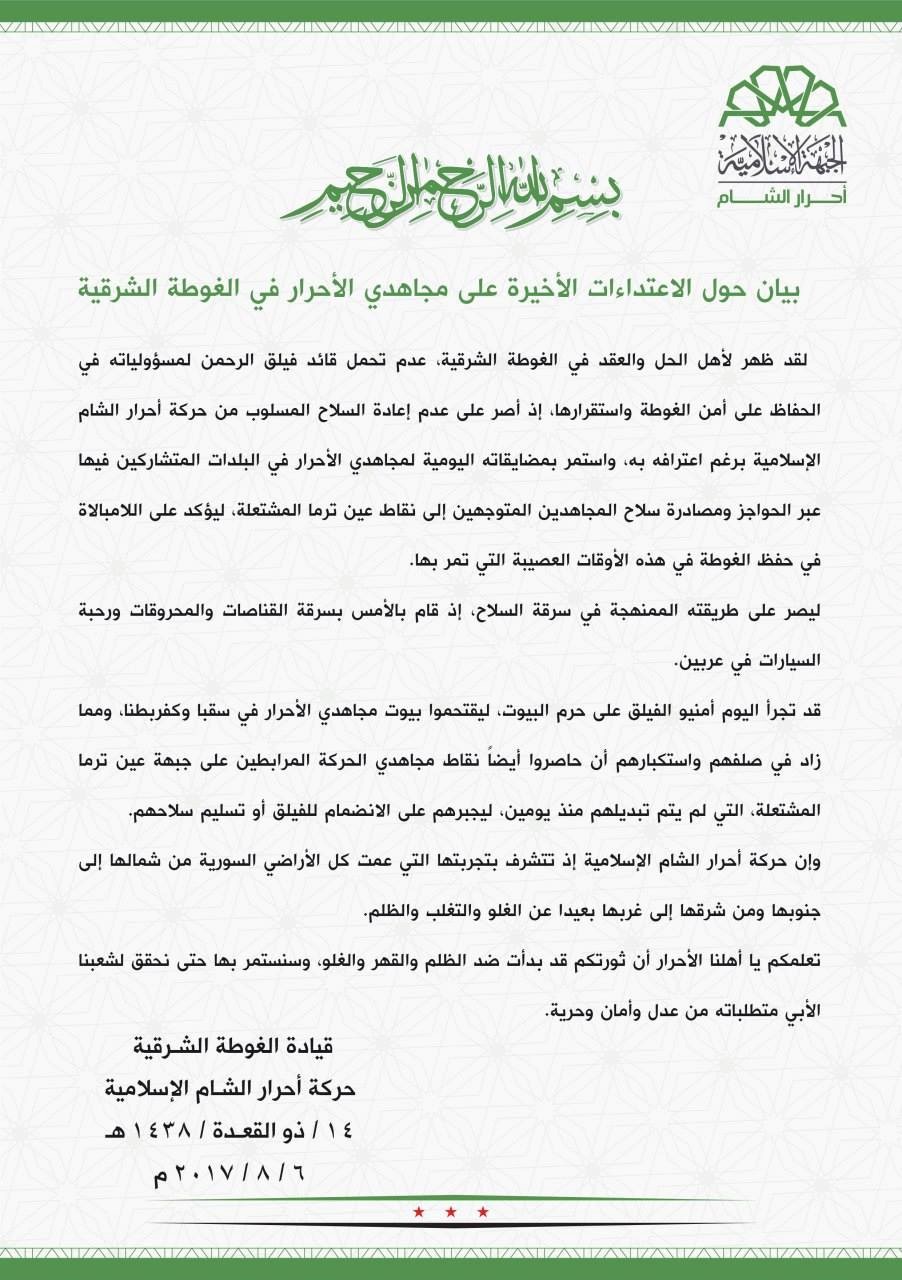
Image of the statement published by Ahrara al-Sham al-Islamiyya on August 6, 2017, demanding the return of weapons by Failaq al-Rahman.
Photo credit: official page of Ahrar al-Sham Islamiyya movement.

Image of the statement published by Wael Alwan, the spokesperson of Failaq al-Rahman on Twitter on August 6, 2017, which he responded to Ahrar al-Sham al-Islamiyya and condemned its alliance with Hayat Tahrir al-Sham instead of supporting Failaq al-Rahman in Jobar front.
Photo credit: official Failaq al-Rahman spokesman’s account on Twitter.
As a result of this disagreement between Failaq al-Rahman and Ahrar al-Sham al-Islamiyya, there was a clash between them in the town of Madyara and the city of Irbin. However, Ahrar al-Sham al-Islamiyya was supported by Hayat Tahrir al-Sham stationed in al-Ash’ari farms, the confrontations ended with Failaq al-Rahman controlling Irbin, Ahrar al-Sham al-Islamiyya seizing buildings on the outskirts of the town of Hazeh and deploying snipers on them, following this, Failaq al-Rahman carried out a campaign arresting HTS agents in Kafr Batna. In turn, Ahrar al-Sham al-Islamiyya, in cooperation with HTS attacked Failaq al-Rahman headquarters in Madyara. Meantime Army of Islam exploited all that, and suddenly attacked HTS headquarters in al-Ash’ari farms, and controlled part of it.
In turn, Failaq al-Rahman confirmed that the attack by Army of Islam on al-Ash’ari farms aimed its headquarters, not the HTS ones, as HTS had withdrawn from the area before Army of Islam entered it, and the confirmation was in the statement of Wael Alwan, Failaq al-Rahman spokesperson, on Twitter on August 7, 2017.
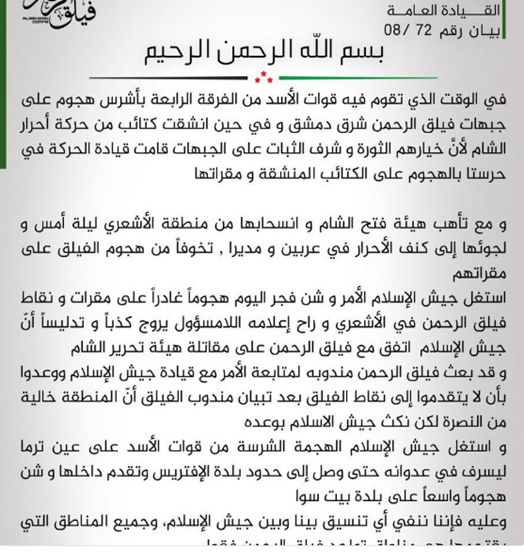
Image of the statement published by Wael Alwan, the spokesman of Failaq al-Rahman, on August 7, 2017, in which he replied to allegations of Army of Islam in attacking headquarters of HTS in al-Ash’ari Farms, confirming that the attack, targeted its headquarters.
Photo credit: official spokesman of Failaq al-Rahman on Twitter.
For its part, Army of Islam responded to the recent allegations of Failaq al-Rahman through a statement published on August 8, 2017, in which it denied any attack on Failaq al-Rahman positions, accusing it of complicity with HTS. This sparked a war of statements between the two parties, and alerted the locals of returning the ghost of the military confrontations again.
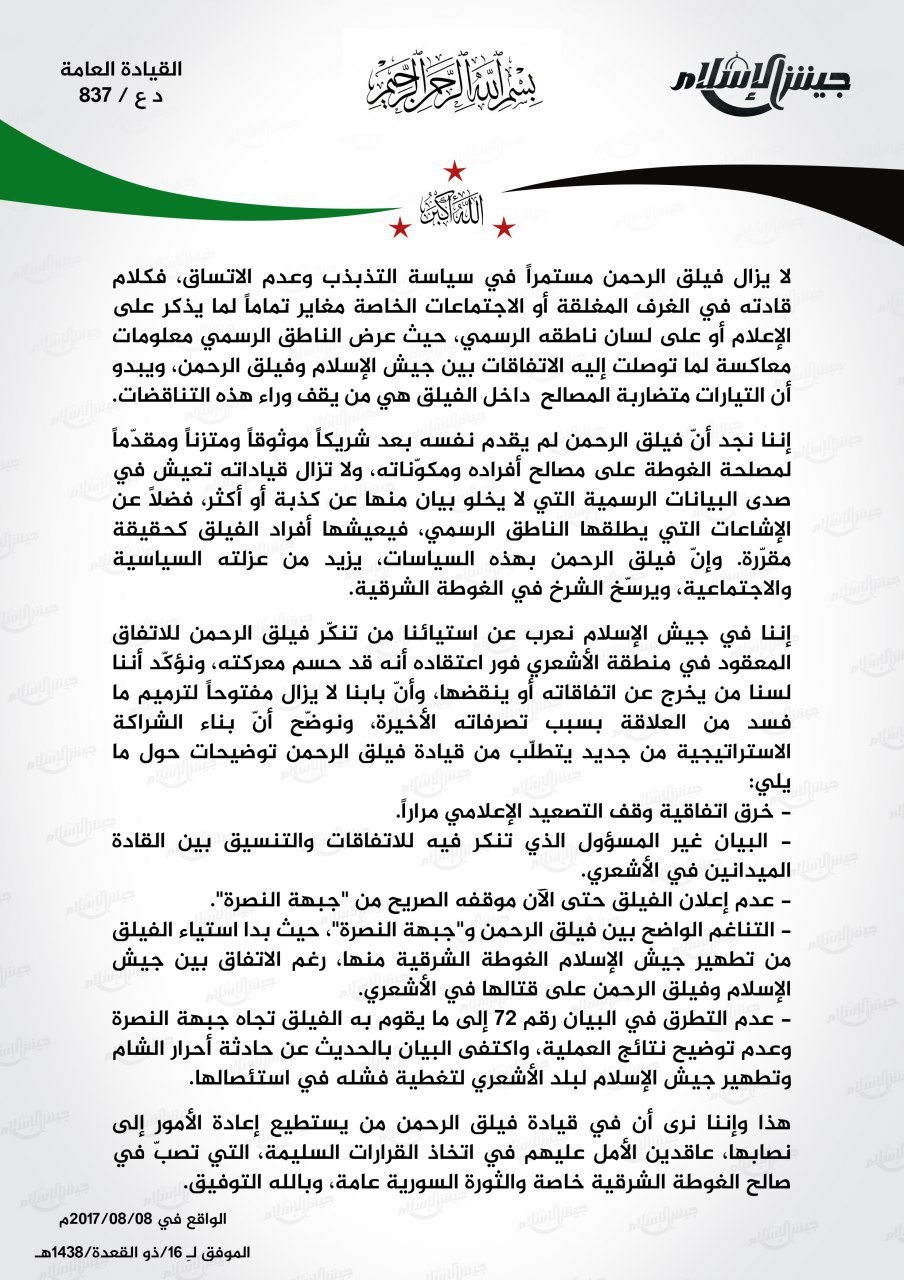
Image showing the statement published by Army of Islam on August 8, 2017, in which he responded to Failaq al-Rahman, requesting clarification of his statue from HTS and stopping media rumors.
Photo credit: official page of Army of Islam.
The recent clashes between the two sides resulted in the death of a civilian identified as Ali Zaghloul, as a result of a mistaken bullet. Muhammad. M, an activist of Irbin, confirmed that and spoke to STJ about the demonstrations that roamed Irbin to express the popular rage of the continued Inter-factional military confrontations, he said:
“During the dispute between Ahrar al-Sham al-Islamiyya and Failaq Al-Rahman, HTS took advantage of the opportunity, immediately entered headquarters of Ahrar al-Sham al-Islamiyya and looted everything, and when the latter came back, it accused Failaq al-Rahman of doing that, which caused dispute. Those skirmishes and successive clashes increased suffering of civilians and further oppressed on them as well, so protests demonstrations erupted and roamed around Irbin, commenced from Monday, August 7, 2017, to Friday, August 11, 2017, to express public rage because of the aggravated security situation in Eastern Ghouta. The demonstrations would not go without violations against demonstrators. Concerning the demonstration on Wednesday, August 9, 2017, which demanded the pull of HTS out of the city, Ahrar al-Sham al-islamiyya dispersed the demonstrators by shooting in the air, after stone throwing between both parties without any significant injuries. On Friday, August 11, 2017, HTS faced the demonstrators by throwing stones, resulting in injuries.”
A video footage released on August 11, 2017 by Omawi News Agency showed that many demonstrators had commenced from Irbin demanding the departure of HTS from the city, the video also showed some of the wounded from demonstrators as a result of being stoned by HTS.
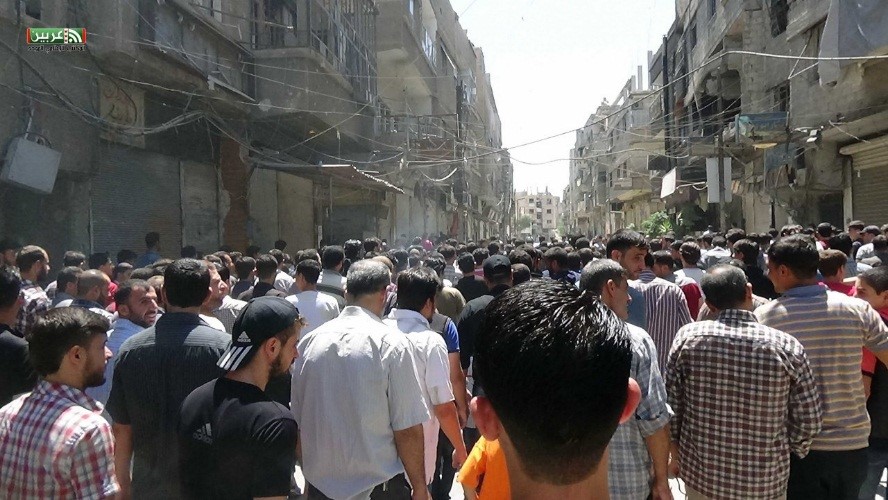
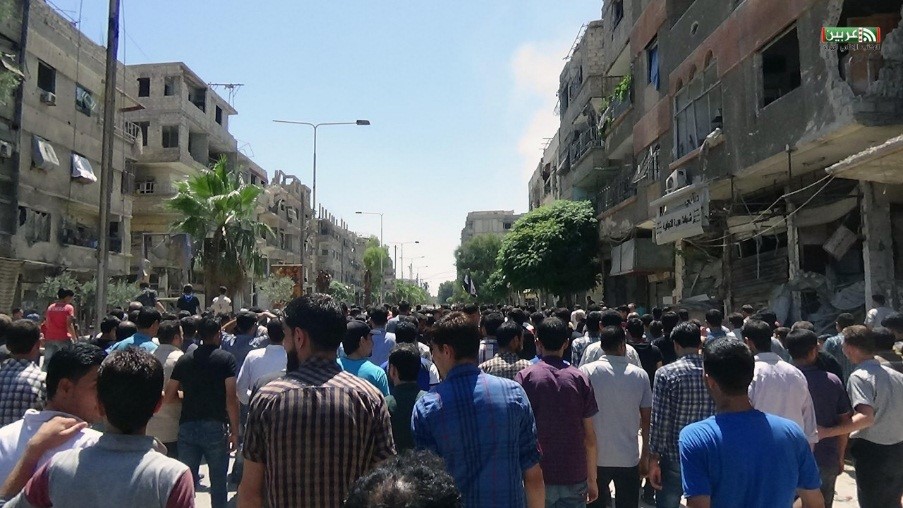
Images of demonstrations in Irbin on August 11, 2017, demanded the departure of HTS from the city and the cessation of inter-factional military confrontations.
Photo credit: Facebook page of the Unified Media Office in Irbin.
It is worth mentioning that STJ had documented in a previous report the death and injury of civilians, following Army of Islam opened fire on one of the demonstrations that came out in the city of Irbin on April 30, 2017, which demanded the cessation of military confrontations between armed opposition factions in Eastern Ghouta.
[1] It is mentioned that military confrontations erupted between both Army of Islam and Failaq al-Rahman on April 28, 2016, and lasted for almost a month, and were renewed after a year on the same date, these confrontations caused the death of a large number of soldiers and civilians, estimated about one thousand in two years depending on sources inside Ghouta.
[2] The Army of Islam: in September 2011, "Zahran Aloush", the former prisoner in Sednaya Prison, announced the formation of the opposition Battalion of Islam that later became, in mid-2012, Liwa al-Islam. On September 29, 2013, the brigade merged with a number of other factions to announce the formation of the "Army of Islam" and later joined Islamic Front, in the same year, including other Islamic brigades, al-Tawhid Brigade, Suqour al-Sham, Ahrar al-Sham Islamiyya movement, and Liwa al-Haqq, and Zahran was the commander. The army is now mainly active in the Eastern Ghouta area of Damascus countryside, but is also located in most areas out of control of the Syrian government except areas under ISIS and the Syrian Democratic Forces SDF.
[3] At the beginning of August 2012, the formation of al-Baraa Brigade, led by dissent captain "Abdel Nasser Shammeir", hails from Homs province, was announced and, and at the end of 2013, the brigade expanded after several brigades and factions joined it, including: Abu Musa al-Ash’ari brigade, Liwa Shuhada al-Ghouta, Ahl al-Sham Brigades, , al-Liwaa al-Awal in Qaboun and Tishreen neighborhood and al-Adiyat Battalion in Western Ghouta. According to several sources, this brigade has about 9,000 fighters. It gains influence from its areas in the neighborhoods of the east of the capital, such as Jobar, Zamalka and others, and is the second largest opposition military faction in Ghouta, after Army of Islam.
[4] On January 28, 2017, several jihadist factions in northern Syria announced the merger under the name Hayat Tahrir al-Sham /HTS/ they are Fatah al-sham Front, formerly al-Nusra Front, Nour al-Din al-Zenki Movement, Liwaa al-Haqq and Ansar al-Din Front and Jaish al-Sunna. However, at background of the recent outbreak of confrontations between Ahrar al-Sham al-Islamiyya and Hayat Tahrir al-Sham (HTS) in the north of Syria on July 15, 2017, Nour al-Din al-Zenki movement announced its separation from HTS on July 20, 2017.
[5] This brigade is a new military formation, established on May 18, 2016, included a number of defectors of Hayat Tahrir al-Sham (HTS), Ahrar al-Sham al-Islamiyya and Army of Islam, this brigade did not obtain any legitimacy from the military junta, and was preparing for a battle in the area of Maliha and Marj but it did not complete that. This brigade, according to people from Ghouta, is a new façade of the Hayat Tahrir al-Sham (HTS) as it was the only one that acknowledged it.
[6] The town of Beit Sawa is under the control of Failaq al-Rahman, but part of the town's farms are held by Army of Islam, which illustrated the shooting of the demonstration by the latter.
[7] Ahrar al-Sham al-Islamiyya was founded on November 11, 2011, with an estimated 25,000 combatants; it is one of the Islamic military factions that formed after the merger of four Islamic factions, namely, Ahrar al-Sham brigades, Fajr al-Islamiyya movement and al-Taliaa al-Islamiyya Group and al-Iman al-Mouqitela Brigades. The movement activates in many areas beyond the control of the Syrian government, particularly in Idlib, Aleppo and Hama, it is currently headed by a former prisoner at Sednaya Military Prison who was sentenced for 12 years (Hassan Sawan/Abu al-Bara), born in Latakia, 1979, and was released following an exchange deal at the end of 2016.

